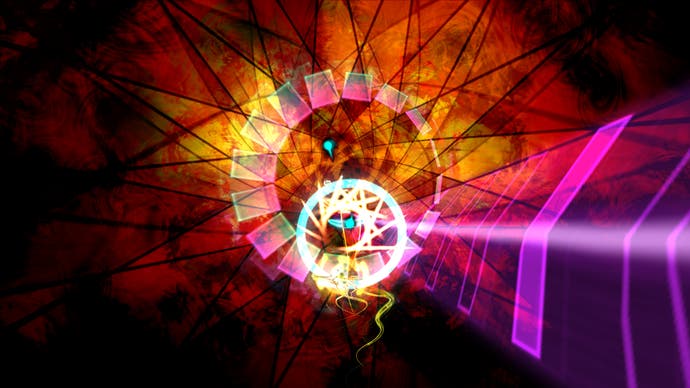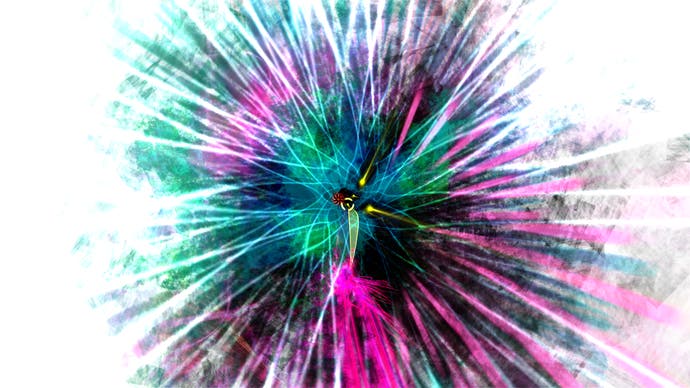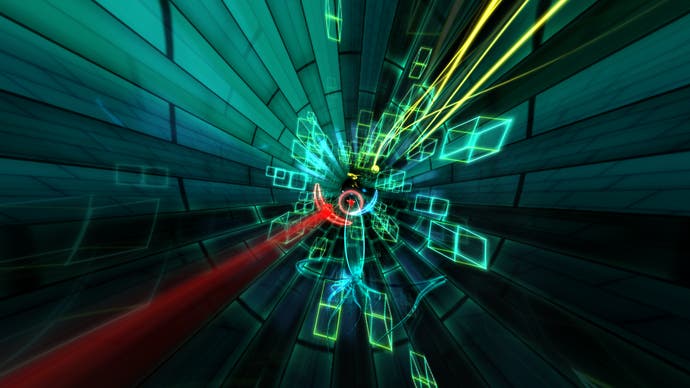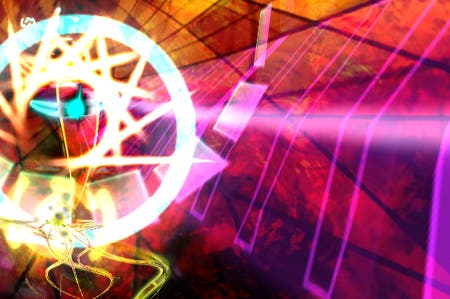Dyad Review
All of the lights...
Dyad's lineage is rich and favoured. As you barrel down its endless tunnels, flashes of Tempest, WipeOut, Rez, Frequency and Internal Section are caught in its smeary pixels. But at its core, it's quite unlike any of these.
Rather, you must haul yourself along its inscrutable track by grasping onto light points with an esoteric grappling hook made of laser and neon, heaving the ball of light that represents you onwards. Each lurch skims your brilliant avatar forward with inertia, before it slows to a standstill until you grab the next point and pull again.
It's a game built to elicit flow - that transcendental state in which the conscious barriers between thought and game dissipate, your eyes endlessly darting around the point horizon, searching for the bright lights than represent the anchor points on Dyad's horizontal cliff face. You build speed with each tug and, if you manage to find the next latch point before you begin to slow, it's possible to accelerate over consecutive heaves with all the quickening rhythm and pace of a 100m sprinter.

Initially, this is a one-button affair, the left analogue stick used to rotate the tunnel in order to bring the next anchor light into your sights. Linking pairs of like-coloured lights generates bonus speed and, more often than not, the aim is to make it to the end of the track as quickly as possible. Then, level by level, complexity is added in tidy increments.
In time, grazing the light anchors (as in a bullet hell shoot-'em-up) builds a special meter which, when filled, allows you to trigger a 'Lance' lunge through the anchor points for dizzying speed boosts. However, strike an anchor point in 'normal' mode and the stage will rewind the previous few seconds' play, sending you tumbling down the leaderboards along with the physical setback. Later, you can create zip-lines between like-coloured anchor points, which grant a speed boost as you slide along them: a neat risk/reward bonus as you must swerve out of the way of the lights at the last moment lest you career into them and incur another penalty.
Dyad's systems sound overwhelming, but its elegant structure adds complexity in thin layers, leading you down a wormhole of play in thoughtful, manageable darts. By the end of the game you are managing a wide array of techniques, making fight/flight choices in microsecond windows.
One-man developer Shawn McGrath's multi-disciplinary expertise is evident in every area of the game, from the bold, design-savvy presentation - which makes many PSN titles from major studios look rough-edged and amateurish - to the eclectic soundtrack, whose rolling timpani and horn stabs work in concert with the visuals to provoke a trance-like state.

But Dyad is a more focused score-attack game than those you'll find in Tetsuya Mizuguchi's oeuvre. It slips between genres from stage to stage, as the goals and win criteria shift. In one area, your task might be to reach your top speed as fast as possible, in another to tether a set number of anchor points together, in another to complete a series of segments against the clock. As in Geometry Wars, the first thing you see after each stage is the global leaderboard: a thrown gauntlet to try again and improve yourself before daring to move on.
Each of the game's 26 stages also comes with an associated replay challenge. These are unlocked when you achieve the top three-star ranking and offer stricter goals, such as demanding you complete an area within a certain time-limit or lance a set number of enemies using no more than a certain number of button presses. These tasks offer the game's tallest challenges, even the earliest stages requiring practice and dedication before they yield to your efforts. For those players who like to collect all of the trophies in a set, Dyad is one of the toughest games on PlayStation 3.
Despite the difficulty at the deep end, Dyad's low barrier to entry and top-level simplicity makes it a welcoming experience no matter what your skill level. Likewise, McGrath's use of time penalties rather than 'lives' or restarts to punish mistakes makes this a less frustrating proposition than the arcade games from which it draws inspiration. But the heavy emphasis on leaderboards draws you in to compete, to better yourself. While the smeary, inexact visuals imply that this is a loose, imprecise game, beneath the colour and lights its focused, rigid rule set betrays its arcade heritage.

As with all games built to engender flow, Dyad can feel unrewarding when you're not in that rare state - when you're awkwardly grasping at anchor points and nothing's quite latching properly, and you lumber forward under the Sauron-like eye of the clock. In these moments, you will hate the game.
But that disgust is more honestly directed at yourself: Dyad merely holds a mirror up to your own failings. If you take the time to master the machine, to level up your own eyes and hands and co-ordination, then this is a game to amplify those tiny victories; to put your name in lights.

